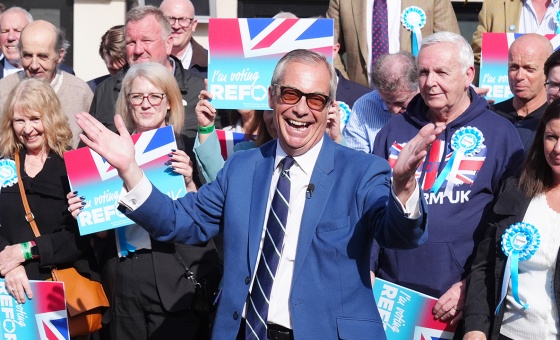This is the last article you can read this month
You can read more article this month
You can read more articles this month
Sorry your limit is up for this month
Reset on:
Please help support the Morning Star by subscribing here
There were once three and a half million of our native red squirrels (Sciurus vulgaris) in the forests and woodlands of Britain.
Today that population is down to well under 150,000 and although still reducing dramatically a number of initiatives are reducing the rate of decline.
What happened? Well, in 1876 some stupid aristocrat decided to import grey squirrels (Scirius caroliniensis) from their native North America releasing them in Henbury Park, Cheshire.
It’s not clear why they were introduced, probably as a live novelty garden decoration. Rich Victorian land owners simply had no idea about the risks of introducing non-native species to their estates.
Other landowners in other parts of Britain also imported the greys which spread rapidly. There are now estimated to be about 2.5 million grey squirrels in Britain.
Unlike the bold and oft seen greys our native red squirrels are very shy and elusive and spend much of their time in the tree canopy. Telltale signs to look for include large dreys in trees, scratch marks on bark and chewed pine cones that look like chewed apple cores. You might also hear the distinctive “chuk chuk” noise they make.
Although the grey squirrels don’t actually attack the native reds they carry the squirrel pox virus which is fatal to red squirrels without harming its grey carriers. Squirrels come in all colours.
Entirely black ones are becoming common and originate in colder regions of Canada where their dark skins absorb more winter sun to keep them warm.
A family of at least two dozen pure white squirrels have been hitting the headlines in Edinburgh. Both these black and white varieties are actually greys — if that makes sense.
Colours are very variable and some grey squirrels can have red fur down their backs and on their feet. Red squirrels usually have russet red fur, although coat colour can vary with some reds appearing very grey. Reds are smaller than the greys with ear tuffs — large tuffs in winter.
By being larger, more robust and able to eat a broader diet, grey squirrels compete more successfully for food and places to live with the reds. Greys cause damage immense damage to woodland by stripping the bark from trees in search of sweet sap which leads to the death of the tree. They are also devastating plunderers of birds’ eggs and chicks.
Now there is another threat to the red squirrel. Populations of reds on Brownsea Island in Poole Harbour and in parts of Scotland have been found to carry the leprosy bacteria. Although it is the same disease that can be passed to humans, experts believe this poses little real danger.
But there are already calls for the animals to be culled. There are still many places in Britain where you can see red squirrels — their introduction to Tresco in the Isles of Scilly in 2014 has been a huge success and they have become a tourist attraction.
Reds from Anglesey have crossed the Menai Strait and started breeding on the mainland and have been seen in gardens in Bangor. A new project — Painting the Town Red — aims to clear grey squirrels from the town so that red squirrels can recolonise Bangor’s parks and open spaces.
They build large nests, called dreys, often in the forks of tree trunks and are usually solitary, only coming together to mate. Related squirrels will share dreys to keep warm during cold winter months.
Reds range widely, especially when looking for mates. They produce young, called kittens, in the spring and can sometimes reproduce a second time in the summer if conditions are right.
Courtship displays high in the trees can be spectacular. Females usually have two or three kittens but litters can have up to six young. Females bring up the young and are very protective.
Up to half of kittens survive to adulthood. Young red squirrels are weaned off their mother’s milk after about two to three months, when they have developed a complete set of teeth.
They are mostly seed eaters and favour pine cones, but also eat larch and spruce. Their diet also includes fungi, shoots and fruits of shrubs and trees, and occasionally birds’ eggs.
They are picky eaters choosing between good and bad nuts by holding them in their paws in the characteristic nursery story pose.
Reds do not hibernate and store fungi in trees to eat over the winter months. They put on weight in the autumn when food is plentiful to help them through the winter. Females need to be fat and healthy so as to be in good condition for breeding.
The main threats to the survival of the reds are the increasing number of grey squirrels, the squirrel pox virus and, not least, road traffic.
The main predators of red squirrels are birds of prey such as goshawks and the pine marten now reestablishing itself in our more remote woodlands. In some urban areas domestic cats and irate bird table fans are also a threat when squirrels go into gardens to raid bird feeders.
However, help is at hand as more and more foresters, wild food enthusiasts and red squirrel fans are trapping and shooting the greys and a surprising number are reaching the game market in traditional dishes like squirrel pie.
Squirrel meat is low in fat, usually low in food miles and completely free range. Some claim the grey squirrel is about as ethical a dish as it is possible to serve.
To food writers it tastes like wild boar — to others more a cross between duck and lamb or a sweetish rabbit. It’s moist and sweet because its diet has been berries and nuts. One dealer in Suffolk sells hundreds at a fiver a time. He suggests a marinade of maple syrup and garlic for the best barbecued squirrel you have ever tasted. Remember every grey you eat gives a native red a chance to survive and repopulate our woods and forests.
We need your support to keep running. If you like what you read please donate by clicking here






